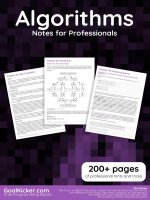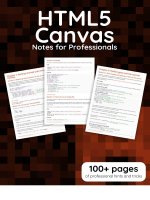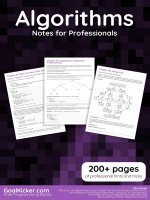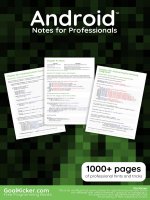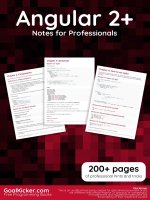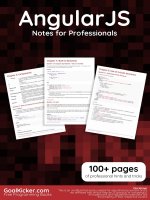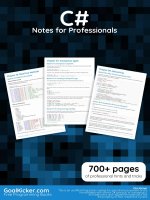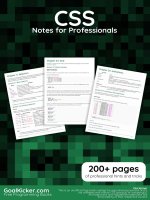RubyOnRails notes for professionals
Bạn đang xem bản rút gọn của tài liệu. Xem và tải ngay bản đầy đủ của tài liệu tại đây (2.06 MB, 231 trang )
Ruby on
Rails
Ruby on Rails
Notes for Professionals
®
Notes for Professionals
200+ pages
of professional hints and tricks
GoalKicker.com
Free Programming Books
Disclaimer
This is an unocial free book created for educational purposes and is
not aliated with ocial Ruby® on Rails group(s) or company(s).
All trademarks and registered trademarks are
the property of their respective owners
Contents
About ................................................................................................................................................................................... 1
Chapter 1: Getting started with Ruby on Rails .............................................................................................. 2
Section 1.1: Creating a Ruby on Rails Application ...................................................................................................... 2
Section 1.2: Create a new Rails app with your choice of database and including the RSpec Testing Tool
.................................................................................................................................................................................. 4
Section 1.3: Generating A Controller ............................................................................................................................ 4
Section 1.4: Installing Rails ............................................................................................................................................ 5
Section 1.5: Create a new Rails app with a non-standard database adapter ........................................................ 7
Section 1.6: Creating Rails APIs in JSON ...................................................................................................................... 7
Section 1.7: Generate a Resource with Scaolds ....................................................................................................... 8
Chapter 2: Routing ..................................................................................................................................................... 10
Section 2.1: Resource Routing (Basic) ....................................................................................................................... 10
Section 2.2: Constraints .............................................................................................................................................. 11
Section 2.3: Scoping routes ........................................................................................................................................ 13
Section 2.4: Concerns .................................................................................................................................................. 15
Section 2.5: Root route ............................................................................................................................................... 16
Section 2.6: Split routes into multiple files ................................................................................................................ 16
Section 2.7: Additional RESTful actions ..................................................................................................................... 17
Section 2.8: Member and Collection Routes ............................................................................................................. 17
Section 2.9: Mount another application .................................................................................................................... 18
Section 2.10: Nested Routes ....................................................................................................................................... 18
Section 2.11: Redirection .............................................................................................................................................. 19
Section 2.12: Redirects and Wildcard Routes ........................................................................................................... 19
Section 2.13: Scope available locales ........................................................................................................................ 19
Section 2.14: URL params with a period ................................................................................................................... 20
Chapter 3: ActiveRecord ......................................................................................................................................... 21
Section 3.1: Creating a Model via generator ............................................................................................................. 21
Section 3.2: Introduction to Callbacks ....................................................................................................................... 21
Section 3.3: Creating a Model manually ................................................................................................................... 22
Section 3.4: Manually Testing Your Models .............................................................................................................. 23
Section 3.5: Creating A Migration .............................................................................................................................. 23
Section 3.6: Create a Join Table using Migrations ................................................................................................... 24
Section 3.7: Using a model instance to update a row ............................................................................................. 25
Chapter 4: Views ......................................................................................................................................................... 26
Section 4.1: Structure ................................................................................................................................................... 26
Section 4.2: Partials ..................................................................................................................................................... 26
Section 4.3: AssetTagHelper ...................................................................................................................................... 27
Section 4.4: Replace HTML code in Views ................................................................................................................ 28
Section 4.5: HAML - an alternative way to use in your views ................................................................................. 29
Chapter 5: ActiveRecord Migrations ................................................................................................................. 31
Section 5.1: Adding multiple columns to a table ....................................................................................................... 31
Section 5.2: Add a reference column to a table ...................................................................................................... 31
Section 5.3: Rollback migrations ................................................................................................................................ 32
Section 5.4: Add a new column with an index .......................................................................................................... 32
Section 5.5: Run specific migration ........................................................................................................................... 33
Section 5.6: Redo migrations ..................................................................................................................................... 33
Section 5.7: Add a new column to a table ................................................................................................................ 33
Section 5.8: Remove an existing column from a table ............................................................................................ 34
Section 5.9: Add column with default value ............................................................................................................. 34
Section 5.10: Running migrations in dierent environments .................................................................................. 35
Section 5.11: Create a new table ................................................................................................................................. 35
Section 5.12: Running migrations ............................................................................................................................... 35
Section 5.13: Change an existing column’s type ....................................................................................................... 35
Section 5.14: Create a hstore column ........................................................................................................................ 36
Section 5.15: Create a join table ................................................................................................................................. 36
Section 5.16: Add a self reference .............................................................................................................................. 37
Section 5.17: Create an array column ....................................................................................................................... 37
Section 5.18: Add an unique column to a table ........................................................................................................ 37
Section 5.19: Checking migration status ................................................................................................................... 38
Section 5.20: Changing Tables .................................................................................................................................. 38
Section 5.21: Adding a NOT NULL constraint to existing data ................................................................................ 38
Section 5.22: Forbid null values ................................................................................................................................. 39
Chapter 6: Rails Best Practices ............................................................................................................................ 40
Section 6.1: Fat Model, Skinny Controller .................................................................................................................. 40
Section 6.2: Domain Objects (No More Fat Models) ............................................................................................... 40
Section 6.3: Beware of default_scope ...................................................................................................................... 42
Section 6.4: Convention Over Configuration ............................................................................................................ 44
Section 6.5: Don't Repeat Yourself (DRY) ................................................................................................................. 45
Section 6.6: You Ain’t Gonna Need it (YAGNI) ........................................................................................................... 45
Chapter 7: Naming Conventions ......................................................................................................................... 47
Section 7.1: Controllers ................................................................................................................................................ 47
Section 7.2: Models ...................................................................................................................................................... 47
Section 7.3: Filenames and autoloading ................................................................................................................... 47
Section 7.4: Views and Layouts ................................................................................................................................. 48
Section 7.5: Models class from Controller name ...................................................................................................... 48
Chapter 8: ActionCable ............................................................................................................................................ 49
Section 8.1: User Authentication ................................................................................................................................. 49
Section 8.2: [Basic] Server Side ................................................................................................................................. 49
Section 8.3: [Basic] Client Side (Coeescript) .......................................................................................................... 49
Chapter 9: ActiveModel ............................................................................................................................................ 51
Section 9.1: Using ActiveModel::Validations .............................................................................................................. 51
Chapter 10: User Authentication in Rails ........................................................................................................ 52
Section 10.1: Authentication using Devise .................................................................................................................. 52
Section 10.2: Devise Controller Filters & Helpers ...................................................................................................... 52
Section 10.3: Omniauth ................................................................................................................................................ 53
Section 10.4: has_secure_password ......................................................................................................................... 53
Section 10.5: has_secure_token ................................................................................................................................ 53
Chapter 11: ActiveRecord Associations ............................................................................................................ 55
Section 11.1: Polymorphic association ........................................................................................................................ 55
Section 11.2: Self-Referential Association .................................................................................................................. 55
Section 11.3: belongs_to .............................................................................................................................................. 56
Section 11.4: has_one .................................................................................................................................................. 56
Section 11.5: has_many ............................................................................................................................................... 56
Section 11.6: The has_many :through association ................................................................................................... 57
Section 11.7: The has_one :through association ....................................................................................................... 57
Section 11.8: The has_and_belongs_to_many association ................................................................................... 58
Chapter 12: ActiveRecord Validations .............................................................................................................. 59
Section 12.1: Validating length of an attribute .......................................................................................................... 59
Section 12.2: Validates format of an attribute .......................................................................................................... 59
Section 12.3: Validating presence of an attribute .................................................................................................... 59
Section 12.4: Custom validations ................................................................................................................................ 60
Section 12.5: Validates inclusion of an attribute ....................................................................................................... 60
Section 12.6: Grouping validation ............................................................................................................................... 61
Section 12.7: Validating numericality of an attribute ............................................................................................... 61
Section 12.8: Validate uniqueness of an attribute .................................................................................................... 62
Section 12.9: Skipping Validations .............................................................................................................................. 62
Section 12.10: Confirmation of attribute .................................................................................................................... 62
Section 12.11: Using :on option .................................................................................................................................... 63
Section 12.12: Conditional validation .......................................................................................................................... 63
Chapter 13: ActiveRecord Query Interface .................................................................................................... 64
Section 13.1: .where ...................................................................................................................................................... 64
Section 13.2: .where with an array ............................................................................................................................. 64
Section 13.3: Scopes .................................................................................................................................................... 65
Section 13.4: Get first and last record ........................................................................................................................ 66
Section 13.5: Ordering ................................................................................................................................................. 67
Section 13.6: where.not ................................................................................................................................................ 67
Section 13.7: Includes ................................................................................................................................................... 68
Section 13.8: Joins ........................................................................................................................................................ 68
Section 13.9: Limit and Oset ..................................................................................................................................... 69
Section 13.10: .find_by ................................................................................................................................................. 69
Section 13.11: .delete_all .............................................................................................................................................. 69
Section 13.12: ActiveRecord case insensitive search ................................................................................................ 69
Section 13.13: .group and .count ................................................................................................................................. 70
Section 13.14: .distinct (or .uniq) .................................................................................................................................. 70
Chapter 14: ActionMailer ......................................................................................................................................... 71
Section 14.1: Basic Mailer ............................................................................................................................................. 71
Section 14.2: Generating a new mailer ...................................................................................................................... 72
Section 14.3: ActionMailer Interceptor ....................................................................................................................... 72
Section 14.4: Adding Attachments ............................................................................................................................. 72
Section 14.5: ActionMailer Callbacks .......................................................................................................................... 73
Section 14.6: Generate a Scheduled Newsletter ....................................................................................................... 73
Chapter 15: Rails generate commands ........................................................................................................... 79
Section 15.1: Rails Generate Controller ...................................................................................................................... 79
Section 15.2: Rails Generate Migration ...................................................................................................................... 80
Section 15.3: Rails Generate Scaold ........................................................................................................................ 80
Section 15.4: Rails Generate Model ............................................................................................................................ 81
Chapter 16: Configuration ...................................................................................................................................... 82
Section 16.1: Custom configuration ............................................................................................................................ 82
Chapter 17: I18n - Internationalization ............................................................................................................. 84
Section 17.1: I18n with arguments ............................................................................................................................... 84
Section 17.2: Translating ActiveRecord model attributes ........................................................................................ 84
Section 17.3: Get locale from HTTP request .............................................................................................................. 86
Section 17.4: Pluralization ............................................................................................................................................ 87
Section 17.5: Set locale through requests ................................................................................................................. 87
Section 17.6: Use I18n with HTML Tags and Symbols .............................................................................................. 89
Section 17.7: Use I18n in views .................................................................................................................................... 89
Chapter 18: Using GoogleMaps with Rails ...................................................................................................... 91
Section 18.1: Add the google maps javascript tag to the layout header ............................................................... 91
Section 18.2: Geocode the model ............................................................................................................................... 91
Section 18.3: Show addresses on a google map in the profile view ....................................................................... 92
Section 18.4: Set the markers on the map with javascript ...................................................................................... 93
Section 18.5: Initialize the map using a coee script class ...................................................................................... 94
Section 18.6: Initialize the map markers using a coee script class ...................................................................... 94
Section 18.7: Auto-zoom a map using a coee script class .................................................................................... 95
Section 18.8: Exposing the model properties as json ............................................................................................... 96
Chapter 19: File Uploads .......................................................................................................................................... 98
Section 19.1: Single file upload using Carrierwave .................................................................................................... 98
Section 19.2: Nested model - multiple uploads ........................................................................................................ 98
Chapter 20: Caching ................................................................................................................................................ 100
Section 20.1: Russian Doll Caching .......................................................................................................................... 100
Section 20.2: SQL Caching ....................................................................................................................................... 100
Section 20.3: Action caching .................................................................................................................................... 101
Section 20.4: Fragment caching .............................................................................................................................. 101
Section 20.5: Page caching ...................................................................................................................................... 102
Section 20.6: HTTP caching ..................................................................................................................................... 102
Chapter 21: ActionController ............................................................................................................................... 103
Section 21.1: Basic REST Controller .......................................................................................................................... 103
Section 21.2: Filters .................................................................................................................................................... 104
Section 21.3: Generating a controller ...................................................................................................................... 106
Section 21.4: Rescuing ActiveRecord::RecordNotFound with redirect_to ........................................................... 107
Section 21.5: Display error pages for exceptions ................................................................................................... 107
Section 21.6: Output JSON instead of HTML .......................................................................................................... 108
Section 21.7: Controllers (Basic) ............................................................................................................................... 108
Section 21.8: Parameters .......................................................................................................................................... 109
Section 21.9: Filtering parameters (Basic) .............................................................................................................. 109
Section 21.10: Redirecting ......................................................................................................................................... 110
Section 21.11: Using Views ......................................................................................................................................... 110
Chapter 22: Configuration .................................................................................................................................... 112
Section 22.1: Rails General Configuration ............................................................................................................... 112
Section 22.2: Configuring assets ............................................................................................................................. 112
Section 22.3: Configuring generators ..................................................................................................................... 112
Section 22.4: Environments in Rails ......................................................................................................................... 113
Section 22.5: Database Configuration .................................................................................................................... 113
Chapter 23: Safe Constantize ............................................................................................................................. 115
Section 23.1: Successful safe_constantize .............................................................................................................. 115
Section 23.2: Unsuccessful safe_constantize ........................................................................................................ 115
Chapter 24: Rails 5 .................................................................................................................................................. 116
Section 24.1: How to install Ruby on Rails 5 on RVM ............................................................................................. 116
Section 24.2: Creating a Ruby on Rails 5 API ......................................................................................................... 116
Chapter 25: Authorization with CanCan ........................................................................................................ 119
Section 25.1: Getting started with CanCan .............................................................................................................. 119
Section 25.2: Handling large number of abilities ................................................................................................... 119
Section 25.3: Defining abilities ................................................................................................................................. 121
Section 25.4: Quickly test an ability ........................................................................................................................ 121
Chapter 26: Mongoid ............................................................................................................................................... 123
Section 26.1: Fields ..................................................................................................................................................... 123
Section 26.2: Installation ........................................................................................................................................... 123
Section 26.3: Creating a Model ................................................................................................................................ 123
Section 26.4: Classic Associations ........................................................................................................................... 124
Section 26.5: Embedded Associations .................................................................................................................... 124
Section 26.6: Database Calls .................................................................................................................................... 125
Chapter 27: Gems ..................................................................................................................................................... 126
Section 27.1: Gemfiles ................................................................................................................................................ 126
Section 27.2: What is a gem? ................................................................................................................................... 126
Section 27.3: Bundler ................................................................................................................................................ 127
Section 27.4: Gemsets ............................................................................................................................................... 127
Chapter 28: Change default timezone .......................................................................................................... 130
Section 28.1: Change Rails timezone AND have Active Record store times in this timezone ........................... 130
Section 28.2: Change Rails timezone, but continue to have Active Record save in the database in UTC
............................................................................................................................................................................. 130
Chapter 29: Asset Pipeline .................................................................................................................................... 131
Section 29.1: Manifest Files and Directives ............................................................................................................. 131
Section 29.2: Rake tasks ........................................................................................................................................... 132
Section 29.3: Basic Usage ........................................................................................................................................ 132
Chapter 30: Upgrading Rails .............................................................................................................................. 133
Section 30.1: Upgrading from Rails 4.2 to Rails 5.0 ............................................................................................... 133
Chapter 31: ActiveRecord Locking ................................................................................................................... 135
Section 31.1: Optimistic Locking ................................................................................................................................ 135
Section 31.2: Pessimistic Locking ............................................................................................................................. 135
Chapter 32: Debugging .......................................................................................................................................... 136
Section 32.1: Debugging Rails Application .............................................................................................................. 136
Section 32.2: Debugging Ruby on Rails Quickly + Beginner advice .................................................................... 136
Section 32.3: Debugging ruby-on-rails application with pry ................................................................................ 138
Section 32.4: Debugging in your IDE ....................................................................................................................... 139
Chapter 33: Configure Angular with Rails .................................................................................................... 141
Section 33.1: Angular with Rails 101 .......................................................................................................................... 141
Chapter 34: Rails logger ....................................................................................................................................... 144
Section 34.1: Rails.logger .......................................................................................................................................... 144
Chapter 35: Prawn PDF .......................................................................................................................................... 145
Section 35.1: Advanced Example ............................................................................................................................. 145
Section 35.2: Basic Example ..................................................................................................................................... 146
Chapter 36: Rails API ............................................................................................................................................... 147
Section 36.1: Creating an API-only application ....................................................................................................... 147
Chapter 37: Deploying a Rails app on Heroku .......................................................................................... 148
Section 37.1: Deploying your application ................................................................................................................ 148
Section 37.2: Managing Production and staging environments for a Heroku ................................................... 150
Chapter 38: ActiveSupport .................................................................................................................................. 152
Section 38.1: Core Extensions: String Access .......................................................................................................... 152
Section 38.2: Core Extensions: String to Date/Time Conversion ......................................................................... 153
Section 38.3: Core Extensions: String Exclusion ...................................................................................................... 153
Section 38.4: Core Extensions: String Filters ........................................................................................................... 153
Section 38.5: Core Extensions: String Inflection ...................................................................................................... 155
Chapter 39: Form Helpers .................................................................................................................................... 158
Section 39.1: Creating a search form ...................................................................................................................... 158
Section 39.2: Dropdown ............................................................................................................................................ 158
Section 39.3: Helpers for form elements ................................................................................................................ 158
Chapter 40: ActiveRecord Transactions ...................................................................................................... 161
Section 40.1: Basic example ..................................................................................................................................... 161
Section 40.2: Dierent ActiveRecord classes in a single transaction .................................................................. 161
Section 40.3: Multiple database connections ......................................................................................................... 161
Section 40.4: save and destroy are automatically wrapped in a transaction ................................................... 161
Section 40.5: Callbacks ............................................................................................................................................. 162
Section 40.6: Rolling back a transaction ................................................................................................................ 162
Chapter 41: RSpec and Ruby on Rails ........................................................................................................... 163
Section 41.1: Installing RSpec .................................................................................................................................... 163
Chapter 42: Decorator pattern ........................................................................................................................ 164
Section 42.1: Decorating a Model using Draper ..................................................................................................... 164
Section 42.2: Decorating a Model using SimpleDelegator ................................................................................... 164
Chapter 43: Elasticsearch .................................................................................................................................... 166
Section 43.1: Searchkick ............................................................................................................................................ 166
Section 43.2: Installation and testing ...................................................................................................................... 166
Section 43.3: Setting up tools for development ..................................................................................................... 167
Section 43.4: Introduction ......................................................................................................................................... 167
Chapter 44: React with Rails using react-rails gem .............................................................................. 168
Section 44.1: React installation for Rails using rails_react gem ........................................................................... 168
Section 44.2: Using react_rails within your application ........................................................................................ 168
Section 44.3: Rendering & mounting ....................................................................................................................... 169
Chapter 45: Rails Cookbook - Advanced rails recipes/learnings and coding techniques
............................................................................................................................................................................................ 170
Section 45.1: Playing with Tables using rails console ............................................................................................ 170
Section 45.2: Rails methods - returning boolean values ....................................................................................... 170
Section 45.3: Handling the error - undefined method `where' for #<Array:0x000000071923f8> ..................... 171
Chapter 46: Multipurpose ActiveRecord columns ................................................................................... 172
Section 46.1: Saving an object .................................................................................................................................. 172
Section 46.2: How To ................................................................................................................................................ 172
Chapter 47: Class Organization ........................................................................................................................ 173
Section 47.1: Service Class ........................................................................................................................................ 173
Section 47.2: Model Class ......................................................................................................................................... 175
Chapter 48: Shallow Routing ............................................................................................................................. 176
Section 48.1: Use of shallow ..................................................................................................................................... 176
Chapter 49: Model states: AASM ...................................................................................................................... 177
Section 49.1: Basic state with AASM ........................................................................................................................ 177
Chapter 50: Rails 5 API Authetication ............................................................................................................ 179
Section 50.1: Authentication with Rails authenticate_with_http_token .............................................................. 179
Chapter 51: Testing Rails Applications ........................................................................................................... 180
Section 51.1: Unit Test ................................................................................................................................................ 180
Section 51.2: Request Test ........................................................................................................................................ 180
Chapter 52: Active Jobs ........................................................................................................................................ 181
Section 52.1: Introduction .......................................................................................................................................... 181
Section 52.2: Sample Job ......................................................................................................................................... 181
Section 52.3: Creating an Active Job via the generator ....................................................................................... 181
Chapter 53: Rails frameworks over the years .......................................................................................... 182
Section 53.1: How to find what frameworks are available in the current version of Rails? ............................... 182
Section 53.2: Rails versions in Rails 1.x .................................................................................................................... 182
Section 53.3: Rails frameworks in Rails 2.x ............................................................................................................. 182
Section 53.4: Rails frameworks in Rails 3.x ............................................................................................................. 182
Chapter 54: Nested form in Ruby on Rails ................................................................................................. 183
Section 54.1: How to setup a nested form in Ruby on Rails ................................................................................. 183
Chapter 55: Factory Girl ....................................................................................................................................... 184
Section 55.1: Defining Factories ............................................................................................................................... 184
Chapter 56: Import whole CSV files from specific folder .................................................................... 185
Section 56.1: Uploads CSV from console command .............................................................................................. 185
Chapter 57: Tools for Ruby on Rails code optimization and cleanup ........................................... 186
Section 57.1: If you want to keep your code maintainable, secure and optimized, look at some gems for
code optimization and cleanup : ..................................................................................................................... 186
Chapter 58: ActiveJob ............................................................................................................................................ 187
Section 58.1: Create the Job ..................................................................................................................................... 187
Section 58.2: Enqueue the Job ................................................................................................................................ 187
Chapter 59: Active Model Serializers .............................................................................................................. 188
Section 59.1: Using a serializer ................................................................................................................................. 188
Chapter 60: Rails Engine - Modular Rails ..................................................................................................... 189
Section 60.1: Create a modular app ........................................................................................................................ 189
Chapter 61: Single Table Inheritance .............................................................................................................. 192
Section 61.1: Basic example ...................................................................................................................................... 192
Section 61.2: Custom inheritance column ............................................................................................................... 192
Section 61.3: Rails model with type column and without STI ................................................................................ 193
Chapter 62: ActiveRecord Transactions ....................................................................................................... 194
Section 62.1: Getting Started with Active Record Transactions ............................................................................ 194
Chapter 63: Turbolinks ........................................................................................................................................... 195
Section 63.1: Binding to turbolink's concept of a page load ................................................................................. 195
Section 63.2: Disable turbolinks on specific links ................................................................................................... 195
Section 63.3: Understanding Application Visits ...................................................................................................... 196
Section 63.4: Cancelling visits before they begin ................................................................................................... 196
Section 63.5: Persisting elements across page loads ............................................................................................ 197
Chapter 64: Friendly ID ......................................................................................................................................... 198
Section 64.1: Rails Quickstart ................................................................................................................................... 198
Chapter 65: Securely storing authentication keys .................................................................................. 200
Section 65.1: Storing authentication keys with Figaro ........................................................................................... 200
Chapter 66: Authenticate Api using Devise ................................................................................................. 201
Section 66.1: Getting Started .................................................................................................................................... 201
Chapter 67: Integrating React.js with Rails Using Hyperloop ........................................................... 203
Section 67.1: Adding a simple react component (written in ruby) to your Rails app ......................................... 203
Section 67.2: Callbacks ............................................................................................................................................. 203
Section 67.3: Declaring component parameters (props) ..................................................................................... 203
Section 67.4: HTML Tags .......................................................................................................................................... 204
Section 67.5: Event Handlers .................................................................................................................................... 204
Section 67.6: States ................................................................................................................................................... 204
Chapter 68: Change a default Rails application enviornment ......................................................... 205
Section 68.1: Running on a local machine .............................................................................................................. 205
Section 68.2: Running on a server ........................................................................................................................... 205
Chapter 69: Rails -Engines ................................................................................................................................... 206
Section 69.1: Famous examples are ........................................................................................................................ 206
Chapter 70: Adding an Amazon RDS to your rails application ......................................................... 207
Section 70.1: Consider we are connecting MYSQL RDS with your rails application ........................................... 207
Chapter 71: Payment feature in rails ............................................................................................................. 208
Section 71.1: How to integrate with Stripe ............................................................................................................... 208
Chapter 72: Rails on docker ................................................................................................................................ 210
Section 72.1: Docker and docker-compose ............................................................................................................ 210
Appendix A: Reserved Words ............................................................................................................................. 212
Section A.1: Reserved Word List .............................................................................................................................. 212
Credits ............................................................................................................................................................................ 218
You may also like ...................................................................................................................................................... 222
About
Please feel free to share this PDF with anyone for free,
latest version of this book can be downloaded from:
/>
This Ruby® on Rails Notes for Professionals book is compiled from Stack Overflow
Documentation, the content is written by the beautiful people at Stack Overflow.
Text content is released under Creative Commons BY-SA, see credits at the end
of this book whom contributed to the various chapters. Images may be copyright
of their respective owners unless otherwise specified
This is an unofficial free book created for educational purposes and is not
affiliated with official Ruby® on Rails group(s) or company(s) nor Stack Overflow.
All trademarks and registered trademarks are the property of their respective
company owners
The information presented in this book is not guaranteed to be correct nor
accurate, use at your own risk
Please send feedback and corrections to
GoalKicker.com – Ruby® on Rails Notes for Professionals
1
Chapter 1: Getting started with Ruby on
Rails
Version Release Date
5.1.5
2018-02-14
5.1.2
2017-06-26
5.0
2016-06-30
4.2
2014-12-19
4.1
2014-04-08
4.0
2013-06-25
3.2
2012-01-20
3.1
2011-08-31
3.0
2010-08-29
2.3
2009-03-16
2.0
2007-12-07
1.2
2007-01-19
1.1
2006-03-28
1.0
2005-12-13
Section 1.1: Creating a Ruby on Rails Application
This example assumes Ruby and Ruby on Rails have already been installed properly. If not, you can find how to do it
in Section 1.4: Installing Rails.
Open up a command line or terminal. To generate a new rails application, use rails new command followed by the
name of your application:
$ rails new my_app
If you want to create your Rails application with a specific Rails version then you can specify it at the time of
generating the application. To do that, use rails _version_ new followed by the application name:
$ rails _4.2.0_ new my_app
This will create a Rails application called MyApp in a my_app directory and install the gem dependencies that are
already mentioned in Gemfile using bundle install.
To switch to your newly created app's directory, use the cd command, which stands for change directory.
$ cd my_app
The my_app directory has a number of auto-generated files and folders that make up the structure of a Rails
application. Following is a list of files and folders that are created by default:
File/Folder
app/
Purpose
Contains the controllers, models, views, helpers, mailers and assets for your application.
bin/
Contains the rails script that starts your app and can contain other scripts you use to setup,
update, deploy or run your application.
config/
Configure your application's routes, database, and more.
GoalKicker.com – Ruby® on Rails Notes for Professionals
2
config.ru
Rack configuration for Rack based servers used to start the application.
db/
Contains your current database schema, as well as the database migrations.
Gemfile Gemfile.lock
These files allow you to specify what gem dependencies are needed for your Rails
application. These files are used by the Bundler gem.
lib/
Extended modules for your application.
log/
Application log files.
public/
The only folder seen by the world as-is. Contains static files and compiled assets.
Rakefile
This file locates and loads tasks that can be run from the command line. The task definitions
are defined throughout the components of Rails.
README.md
This is a brief instruction manual for your application. You should edit this file to tell others
what your application does, how to set it up etc
test/
Unit tests, fixtures, and other test apparatus.
temp/
Temporary files (like cache and pid files).
vendor/
A place for all third-party code. In a typical Rails application this includes vendored gems.
Now you need to create a database from your database.yml file:
Version ≥ 5.0
rake db:create
# OR
rails db:create
Version < 5.0
rake db:create
Now that we've created the database, we need to run migrations to set up the tables:
Version ≥ 5.0
rake db:migrate
# OR
rails db:migrate
Version < 5.0
rake db:migrate
To start the application, we need to fire up the server:
$ rails server
# OR
$ rails s
By default, rails will start the application at port 3000. To start the application with different port number, we need
to fire up the server like,
$ rails s -p 3010
If you navigate to http://localhost:3000 in your browser, you will see a Rails welcome page, showing that your
application is now running.
If it throws an error, there may be several possible problems:
There is a problem with the config/database.yml
You have dependencies in your Gemfile that have not been installed.
You have pending migrations. Run rails db:migrate
In case you move to the previous migration rails db:rollback
GoalKicker.com – Ruby® on Rails Notes for Professionals
3
If that still throws an error, then you should check your config/database.yml
Section 1.2: Create a new Rails app with your choice of
database and including the RSpec Testing Tool
Rails uses sqlite3 as the default database, but you can generate a new rails application with a database of your
choice. Just add the -d option followed by the name of the database.
$ rails new MyApp -T -d postgresql
This is a (non-exhaustive) list of available database options:
mysql
oracle
postgresql
sqlite3
frontbase
ibm_db
sqlserver
jdbcmysql
jdbcsqlite3
jdbcpostgresql
jdbc
The -T command indicate to skip the installation of minitest. To install an alternative test suite like RSpec, edit the
Gemfile and add
group :development, :test do
gem 'rspec-rails',
end
Then launch the following command from the console:
rails generate rspec:install
Section 1.3: Generating A Controller
To generate a controller (for example Posts), navigate to your project directory from a command line or terminal,
and run:
$ rails generate controller Posts
You can shorten this code by replacing generate with g, for example:
$ rails g controller Posts
If you open up the newly generated app/controllers/posts_controller.rb you'll see a controller with no actions:
class PostsController < ApplicationController
# empty
end
It's possible to create default methods for the controller by passing in controller name arguments.
GoalKicker.com – Ruby® on Rails Notes for Professionals
4
$ rails g controller ControllerName method1 method2
To create a controller within a module, specify the controller name as a path like parent_module/controller_name.
For example:
$ rails generate controller CreditCards open debit credit close
# OR
$ rails g controller CreditCards open debit credit close
This will generate the following files:
Controller:
Test:
Views:
Helper:
app/controllers/credit_cards_controller.rb
test/controllers/credit_cards_controller_test.rb
app/views/credit_cards/debit.html.erb [...etc]
app/helpers/credit_cards_helper.rb
A controller is simply a class that is defined to inherit from ApplicationController.
It's inside this class that you'll define methods that will become the actions for this controller.
Section 1.4: Installing Rails
Installing Rails on Ubuntu
On a clean ubuntu, installation of Rails should be straight forward
Upgrading ubuntu packages
sudo apt-get update
sudo apt-get upgrade
Install Ruby and Rails dependecies
sudo apt-get install git-core curl zlib1g-dev build-essential libssl-dev libreadline-dev libyamldev libsqlite3-dev sqlite3 libxml2-dev libxslt1-dev libcurl4-openssl-dev python-software-properties
libffi-dev
Installing ruby version manager. In this case the easy one is using rbenv
git clone ~/.rbenv
echo 'export PATH="$HOME/.rbenv/bin:$PATH"' >> ~/.bashrc
echo 'eval "$(rbenv init -)"' >> ~/.bashrc
Installing Ruby Build
git clone ~/.rbenv/plugins/ruby-build
echo 'export PATH="$HOME/.rbenv/plugins/ruby-build/bin:$PATH"' >> ~/.bashrc
Restart Shell
exec $SHELL
Install ruby
rbenv install 2.3.1
GoalKicker.com – Ruby® on Rails Notes for Professionals
5
rbenv global 2.3.1
rbenv rehash
Installing rails
gem install rails
Installing Rails on Windows
Step 1: Installing Ruby
We need Ruby programming language installed. We can use a precompiled version of Ruby called RubyInstaller.
Download and run Ruby Installer from rubyinstaller.org.
Run the installer. Check "Add Ruby executables to your PATH", then install.
To access Ruby, go to the Windows menu, click All Programs, scroll down to Ruby, and click “Start Command
Prompt with Ruby”. A command prompt terminal will open. If you type ruby -v and press Enter, you should
see the Ruby version number that you installed.
Step 2: Ruby Development Kit
After installing Ruby, we can try to install Rails. But some of the libraries Rails depends on need some build tools in
order to be compiled, and Windows lacks those tools by default. You can identify this if you see an error while
attempting to install Rails Gem::InstallError: The ‘[gem name]’ native gem requires installed build tools.
To fix this, we need to install the Ruby Development Kit.
Download the DevKit
Run the installer.
We need to specify a folder where we’re going to permanently install the DevKit. I recommend installing it in
the root of your hard drive, at C:\RubyDevKit. (Don’t use spaces in the directory name.)
Now we need to make the DevKit tools available to Ruby.
In your command prompt, change to the DevKit directory. cd C:\RubyDevKit or whatever directory you
installed it in.
We need to run a Ruby script to initialize the DevKit setup. Type ruby dk.rb init. Now we’ll tell that same
script to add the DevKit to our Ruby installation. Type ruby dk.rb install.
The DevKit should now be available for your Ruby tools to use when installing new libraries.
Step 3: Rails
Now we can install Rails. Rails comes as a Ruby gem. In your command prompt, type:
gem install rails
Once you press Enter, the gem program will download and install that version of the Rails gem, along with all the
other gems Rails depends on.
Step 4: Node.js
Some libraries that Rails depends on require a JavaScript runtime to be installed. Let’s install Node.js so that those
libraries work properly.
Download the Node.js installer from here.
GoalKicker.com – Ruby® on Rails Notes for Professionals
6
When the download completes, visit your downloads folder, and run the node-v4.4.7.pkg installer.
Read the full license agreement, accept the terms, and click Next through the rest of the wizard, leaving
everything at the default.
A window may pop up asking if you want to allow the app to make changes to your computer. Click “Yes”.
When the installation is complete, you’ll need to restart your computer so Rails can access Node.js.
Once your computer restarts, don’t forget to go to the Windows menu, click “All Programs”, scroll down to Ruby,
and click “Start Command Prompt with Ruby”.
Section 1.5: Create a new Rails app with a non-standard
database adapter
Rails is shipped by default with ActiveRecord, an ORM (Object Relational Mapping) derived from the pattern with
the same name.
As an ORM, it is built to handle relational-mapping, and more precisely by handling SQL requests for you, hence the
limitation to SQL databases only.
However, you can still create a Rails app with another database management system:
1. simply create your app without active-record
$ rails app new MyApp --skip-active-record
2. add your own database management system in Gemfile
gem 'mongoid', '~> 5.0'
3. bundle install and follow the installation steps from the desired database.
In this example, mongoid is an object mapping for MongoDB and - as many other database gems built for rails - it also
inherits from ActiveModel the same way as ActiveRecord, which provides a common interface for many features
such as validations, callbacks, translations, etc.
Other database adapters include, but are not limited to :
datamapper
sequel-rails
Section 1.6: Creating Rails APIs in JSON
This example assumes that you have experience in creating Rails applications.
To create an API-only app in Rails 5, run
rails new name-of-app --api
Add active_model_serializers in Gemfile
gem 'active_model_serializers'
install bundle in terminal
GoalKicker.com – Ruby® on Rails Notes for Professionals
7
bundle install
Set the ActiveModelSerializer adapter to use :json_api
# config/initializers/active_model_serializer.rb
ActiveModelSerializers.config.adapter = :json_api
Mime::Type.register "application/json", :json, %w( text/x-json application/jsonrequest
application/vnd.api+json )
Generate a new scaffold for your resource
rails generate scaffold Task name:string description:text
This will generate the following files:
Controller: app/controllers/tasks_controller.rb
Test:
test/models/task_test.rb
test/controllers/tasks_controller_test.rb
Routes:
resources :tasks added in routes.rb
Migration: db/migrate/_create_tasks.rb
Model:
app/models/task.rb
Serializer: app/serializers/task_serializer.rb
Controller: app/controllers/tasks_controller.rb
Section 1.7: Generate a Resource with Scaolds
From guides.rubyonrails.org:
Instead of generating a model directly . . . let's set up a scaffold. A scaffold in Rails is a full set of model,
database migration for that model, controller to manipulate it, views to view and manipulate the data,
and a test suite for each of the above.
Here's an example of scaffolding a resource called Task with a string name and a text description:
rails generate scaffold Task name:string description:text
This will generate the following files:
Controller: app/controllers/tasks_controller.rb
Test:
test/models/task_test.rb
test/controllers/tasks_controller_test.rb
Routes:
resources :tasks added in routes.rb
Views:
app/views/tasks
app/views/tasks/index.html.erb
app/views/tasks/edit.html.erb
app/views/tasks/show.html.erb
app/views/tasks/new.html.erb
app/views/tasks/_form.html.erb
Helper:
app/helpers/tasks_helper.rb
JS:
app/assets/javascripts/tasks.coffee
CSS:
app/assets/stylesheets/tasks.scss
app/assets/stylesheets/scaffolds.scss
example to delete files generated by scaffold for the resource called Task
GoalKicker.com – Ruby® on Rails Notes for Professionals
8
rails destroy scaffold Task
GoalKicker.com – Ruby® on Rails Notes for Professionals
9
Chapter 2: Routing
The Rails router recognizes URLs and dispatches them to a controller's action. It can also generate paths and URLs,
avoiding the need to hardcode strings in your views.
Section 2.1: Resource Routing (Basic)
Routes are defined in config/routes.rb. They are often defined as a group of related routes, using the resources
or resource methods.
resources :users creates the following seven routes, all mapping to actions of UsersController:
get
post
get
get
get
patch/put
delete
'/users',
'/users',
'/users/new',
'/users/:id/edit',
'/users/:id',
'/users/:id',
'/users/:id',
to:
to:
to:
to:
to:
to:
to:
'users#index'
'users#create'
'users#new'
'users#edit'
'users#show'
'users#update'
'users#destroy'
Action names are shown after the # in the to parameter above. Methods with those same names must be defined
in app/controllers/users_controller.rb as follows:
class UsersController < ApplicationController
def index
end
def create
end
# continue with all the other methods…
end
You can limit the actions that gets generated with only or except:
resources :users, only:
[:show]
resources :users, except: [:show, :index]
You can view all the routes of your application at any given time by running:
Version < 5.0
$ rake routes
Version ≥ 5.0
$ rake routes
# OR
$ rails routes
users
GET
POST
new_user GET
edit_user GET
user
GET
PATCH
PUT
DELETE
/users(.:format)
/users(.:format)
/users/new(.:format)
/users/:id/edit(.:format)
/users/:id(.:format)
/users/:id(.:format)
/users/:id(.:format)
/users/:id(.:format)
users#index
users#create
users#new
users#edit
users#show
users#update
users#update
users#destroy
GoalKicker.com – Ruby® on Rails Notes for Professionals
10
To see only the routes that map to a particular controller:
Version < 5.0
$ rake routes -c static_pages
static_pages_home
GET
/static_pages/home(.:format)
static_pages_help
GET
/static_pages/help(.:format)
static_pages#home
static_pages#help
Version ≥ 5.0
$ rake routes -c static_pages
static_pages_home
GET
/static_pages/home(.:format)
static_pages_help
GET
/static_pages/help(.:format)
static_pages#home
static_pages#help
# OR
$ rails routes -c static_pages
static_pages_home
GET
/static_pages/home(.:format)
static_pages_help
GET
/static_pages/help(.:format)
static_pages#home
static_pages#help
You can search through routes using the -g option. This shows any route that partially matches the helper method
name, the URL path or the HTTP verb:
Version < 5.0
$ rake routes -g new_user
$ rake routes -g POST
# Matches helper method
# Matches HTTP Verb POST
Version ≥ 5.0
$
$
#
$
$
rake routes -g new_user
rake routes -g POST
OR
rails routes -g new_user
rails routes -g POST
# Matches helper method
# Matches HTTP Verb POST
# Matches helper method
# Matches HTTP Verb POST
Additionally, when running rails server in development mode, you can access a web page that shows all your
routes with a search filter, matched in priority from top to bottom, at <hostname>/rails/info/routes. It will look
like this:
Helper
Path / Url
HTTP Verb
Path
[ Path Match ]
Controller#Action
users_path
GET
/users(.:format)
users#index
POST
/users(.:format)
users#create
new_user_path GET
/users/new(.:format)
users#new
edit_user_path GET
/users/:id/edit(.:format) users#edit
user_path
GET
/users/:id(.:format)
users#show
PATCH
/users/:id(.:format)
users#update
PUT
/users/:id(.:format)
users#update
DELETE
/users/:id(.:format)
users#destroy
Routes can be declared available for only members (not collections) using the method resource instead of
resources in routes.rb. With resource, an index route is not created by default, but only when explicitly asking for
one like this:
resource :orders, only: [:index, :create, :show]
Section 2.2: Constraints
You can filter what routes are available using constraints.
GoalKicker.com – Ruby® on Rails Notes for Professionals
11
There are several ways to use constraints including:
segment constraints,
request based constraints
advanced constraints
For example, a requested based constraint to only allow a specific IP address to access a route:
constraints(ip: /127\.0\.0\.1$/) do
get 'route', to: "controller#action"
end
See other similar examples ActionDispatch::Routing::Mapper::Scoping.
If you want to do something more complex you can use more advanced constraints and create a class to wrap the
logic:
# lib/api_version_constraint.rb
class ApiVersionConstraint
def initialize(version:, default:)
@version = version
@default = default
end
def version_header
"application/vnd.my-app.v#{@version}"
end
def matches?(request)
@default || request.headers["Accept"].include?(version_header)
end
end
# config/routes.rb
require "api_version_constraint"
Rails.application.routes.draw do
namespace :v1, constraints: ApiVersionConstraint.new(version: 1, default: true) do
resources :users # Will route to app/controllers/v1/users_controller.rb
end
namespace :v2, constraints: ApiVersionConstraint.new(version: 2) do
resources :users # Will route to app/controllers/v2/users_controller.rb
end
end
One form, several submit buttons
You can also use the value of the submit tags of a form as a constraint to route to a different action. If you have a
form with multiple submit buttons (eg "preview" and "submit"), you could capture this constraint directly in your
routes.rb, instead of writing javascript to change the form destination URL. For example with the
commit_param_routing gem you can take advantage of rails submit_tag
Rails submit_tag first parameter lets you change the value of your form commit parameter
# app/views/orders/mass_order.html.erb
<%= form_for(@orders, url: mass_create_order_path do |f| %>
<!-- Big form here -->
GoalKicker.com – Ruby® on Rails Notes for Professionals
12
<%= submit_tag "Preview" %>
<%= submit_tag "Submit" %>
# => <input name="commit" type="submit" value="Preview" />
# => <input name="commit" type="submit" value="Submit" />
...
<% end %>
# config/routes.rb
resources :orders do
# Both routes below describe the same POST URL, but route to different actions
post 'mass_order', on: :collection, as: 'mass_order',
constraints: CommitParamRouting.new('Submit'), action: 'mass_create' # when the user presses
"submit"
post 'mass_order', on: :collection,
constraints: CommitParamRouting.new('Preview'), action: 'mass_create_preview' # when the user
presses "preview"
# Note the `as:` is defined only once, since the path helper is mass_create_order_path for the form
url
# CommitParamRouting is just a class like ApiVersionContraint
end
Section 2.3: Scoping routes
Rails provides several ways to organize your routes.
Scope by URL:
scope 'admin' do
get 'dashboard', to: 'administration#dashboard'
resources 'employees'
end
This generates the following routes
get
post
get
get
get
patch/put
delete
'/admin/dashboard',
'/admin/employees',
'/admin/employees/new',
'/admin/employees/:id/edit',
'/admin/employees/:id',
'/admin/employees/:id',
'/admin/employees/:id',
to:
to:
to:
to:
to:
to:
to:
'administration#dashboard'
'employees#create'
'employees#new'
'employees#edit'
'employees#show'
'employees#update'
'employees#destroy'
It may make more sense, on the server side, to keep some views in a different subfolder, to separate admin views
from user views.
Scope by module
scope module: :admin do
get 'dashboard', to: 'administration#dashboard'
end
module looks for the controller files under the subfolder of the given name
get
'/dashboard',
to: 'admin/administration#dashboard'
You can rename the path helpers prefix by adding an as parameter
scope 'admin', as: :administration do
GoalKicker.com – Ruby® on Rails Notes for Professionals
13
get 'dashboard'
end
# => administration_dashboard_path
Rails provides a convenient way to do all the above, using the namespace method. The following declarations are
equivalent
namespace :admin do
end
scope 'admin', module: :admin, as: :admin
Scope by controller
scope controller: :management do
get 'dashboard'
get 'performance'
end
This generate these routes
get
get
'/dashboard',
'/performance',
to: 'management#dashboard'
to: 'management#performance'
Shallow Nesting
Resource routes accept a :shallow option that helps to shorten URLs where possible. Resources shouldn't be
nested more than one level deep. One way to avoid this is by creating shallow routes. The goal is to leave off parent
collection URL segments where they are not needed. The end result is that the only nested routes generated are for
the :index , :create , and :new actions. The rest are kept in their own shallow URL context. There are two options
for scope to custom shallow routes:
:shallow_path: Prefixes member paths with a specified parameter
scope shallow_path: "sekret" do
resources :articles do
resources :comments, shallow: true
end
end
:shallow_prefix: Add specified parameters to named helpers
scope shallow_prefix: "sekret" do
resources :articles do
resources :comments, shallow: true
end
end
We can also illustrate shallow routes more by:
resources :auctions, shallow: true do
resources :bids do
resources :comments
end
GoalKicker.com – Ruby® on Rails Notes for Professionals
14
end
alternatively coded as follows (if you’re block-happy):
resources :auctions do
shallow do
resources :bids do
resources :comments
end
end
end
The resulting routes are:
Prefix
bid_comments
Verb
GET
URI Pattern
/bids/:bid_id/comments(.:format)
POST
/bids/:bid_id/comments(.:format)
new_bid_comment GET
/bids/:bid_id/comments/new(.:format)
edit_comment
GET
/comments/:id/edit(.:format)
comment
GET
/comments/:id(.:format)
PATCH /comments/:id(.:format)
PUT
/comments/:id(.:format)
DELETE /comments/:id(.:format)
auction_bids
GET
/auctions/:auction_id/bids(.:format)
POST
/auctions/:auction_id/bids(.:format)
new_auction_bid
GET
/auctions/:auction_id/bids/new(.:format)
edit_bid
GET
/bids/:id/edit(.:format)
bid
GET
/bids/:id(.:format)
PATCH /bids/:id(.:format)
PUT
/bids/:id(.:format)
DELETE /bids/:id(.:format)
auctions
GET
/auctions(.:format)
POST
/auctions(.:format)
new_auction
GET
/auctions/new(.:format)
edit_auction
GET
/auctions/:id/edit(.:format)
auction
GET
/auctions/:id(.:format)
PATCH /auctions/:id(.:format)
PUT
/auctions/:id(.:format)
DELETE /auctions/:id(.:format)
If you analyze the routes generated carefully, you’ll notice that the nested parts of the URL are only included when
they are needed to determine what data to display.
Section 2.4: Concerns
To avoid repetition in nested routes, concerns provide a great way of sharing common resources that are reusable.
To create a concern use the method concern within the routes.rb file. The method expects a symbol and block:
concern :commentable do
resources :comments
GoalKicker.com – Ruby® on Rails Notes for Professionals
15
end
While not creating any routes itself, this code allows using the :concerns attribute on a resource. The simplest
example would be:
resource :page, concerns: :commentable
The equivalent nested resource would look like this:
resource :page do
resource :comments
end
This would build, for example, the following routes:
/pages/#{page_id}/comments
/pages/#{page_id}/comments/#{comment_id}
For concerns to be meaningful, there must be multiple resources that utilize the concern. Additional resources
could use any of the following syntax to call the concern:
resource :post, concerns: %i(commentable)
resource :blog do
concerns :commentable
end
Section 2.5: Root route
You can add a home page route to your app with the root method.
# config/routes.rb
Rails.application.routes.draw do
root "application#index"
# equivalent to:
# get "/", "application#index"
end
# app/controllers/application_controller.rb
class ApplicationController < ActionController::Base
def index
render "homepage"
end
end
And in terminal, rake routes (rails routes in Rails 5) will produce:
root
GET
/
application#index
Because the homepage is usually the most important route, and routes are prioritized in the order they appear, the
root route should usually be the first in your routes file.
Section 2.6: Split routes into multiple files
If your routes file is overwhelmingly big, you can put your routes in multiple files and include each of the files with
Ruby’s require_relative method:
GoalKicker.com – Ruby® on Rails Notes for Professionals
16
